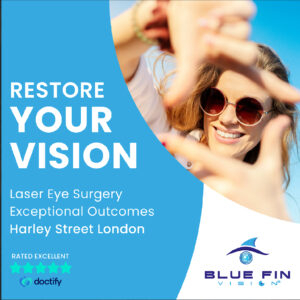Refractive lens exchange (RLE) is becoming an increasingly popular choice for those seeking to correct vision problems that typically develop with age. Unlike traditional laser eye surgeries, RLE replaces the eye’s natural lens with an artificial intraocular lens (IOL) to improve vision. This procedure has gained traction for its ability to address not only presbyopia (the age-related decline in near vision) but also common refractive errors such as nearsightedness, farsightedness, and astigmatism. Because it is designed to treat a wide range of visual impairments, RLE offers a comprehensive solution for individuals looking for lasting, effective vision correction.

As people age, the lens of the eye naturally becomes less flexible, leading to difficulty focusing on close objects—this condition is known as presbyopia. Many individuals begin to rely on reading glasses or bifocals to compensate for this decline. RLE is an ideal solution for these patients, as it involves replacing the eye’s natural lens with a multifocal or accommodating IOL. These advanced lenses allow for clear vision at multiple distances, eliminating the need for reading glasses and restoring more youthful, flexible vision. Multifocal IOLs, in particular, have become a popular choice, as they provide a seamless transition between near, intermediate, and distant vision, improving overall visual clarity without additional corrective eyewear.
Another major advantage of RLE is its ability to treat Refractive lens exchange refractive errors such as nearsightedness (myopia), farsightedness (hyperopia), and astigmatism. Unlike LASIK, which reshapes the cornea to correct these issues, RLE targets the root cause by replacing the eye’s lens. This makes RLE especially beneficial for individuals with high refractive errors, as it is more effective in correcting severe myopia or hyperopia than laser treatments. Toric IOLs, specifically designed for astigmatism, correct the irregularities in the cornea, providing clearer and more stable vision for individuals with this condition.
One of the defining characteristics of RLE is its long-term results. Unlike glasses or contact lenses, which need to be replaced regularly, the artificial lens implanted during RLE is designed to last for a lifetime. As a result, patients who undergo RLE often experience freedom from the constant maintenance and replacement of glasses or contacts. This offers a significant improvement in their quality of life, especially for those who have struggled with deteriorating vision or the inconvenience of corrective eyewear for many years.
RLE is also a preferred option for patients who are not suitable candidates for laser-based eye surgeries like LASIK. These patients may be too old, have corneal irregularities, or have refractive errors that exceed the treatment limits of LASIK. For these individuals, RLE offers an effective alternative that can dramatically improve vision. Additionally, because RLE removes the eye’s natural lens, it is an ideal solution for people with cataracts, a condition where the lens becomes cloudy, causing blurry vision. By replacing the cataract-affected lens with a clear, high-quality IOL, RLE not only treats cataracts but also addresses refractive issues, improving vision across the board.
Though RLE is a safe and well-tolerated procedure, as with any surgery, there are some risks involved. These can include infection, swelling, or changes in the position of the IOL. Some patients may also experience glare or halos around lights, especially in low-light conditions. However, these side effects are generally temporary and can be managed with follow-up care or adjustments to the lens. Serious complications are rare, and the vast majority of patients experience significant improvements in vision with minimal discomfort.
The recovery process for RLE is typically quick. Most patients notice improved vision within a few days, although full stabilization of vision can take a few weeks. Patients are often prescribed eye drops to prevent infection and reduce inflammation and may be advised to avoid activities that could strain the eyes, such as heavy lifting or rubbing the eyes, during the initial recovery period. Regular follow-up appointments are necessary to monitor the healing process and ensure the IOL is in the correct position.
In addition to its clear advantages in treating refractive errors, RLE also offers a significant benefit for patients who wish to reduce or eliminate their dependency on glasses or contact lenses. With its ability to address multiple vision issues in a single procedure, RLE has become a transformative option for individuals seeking long-term vision improvement. Patients who undergo RLE often report a renewed sense of freedom, enjoying activities such as reading, driving, and traveling without the constant need for corrective eyewear.
In conclusion, refractive lens exchange provides a reliable, permanent solution for those who are experiencing age-related vision decline or refractive errors. Its ability to address a wide range of vision problems, coupled with the long-term benefits of an IOL, makes it an attractive option for patients who want clear, stable vision without the need for glasses or contacts. With the continued advancement of IOL technology, RLE will likely remain a cornerstone of refractive surgery, offering patients of all ages the opportunity to enjoy better vision and a higher quality of life.
